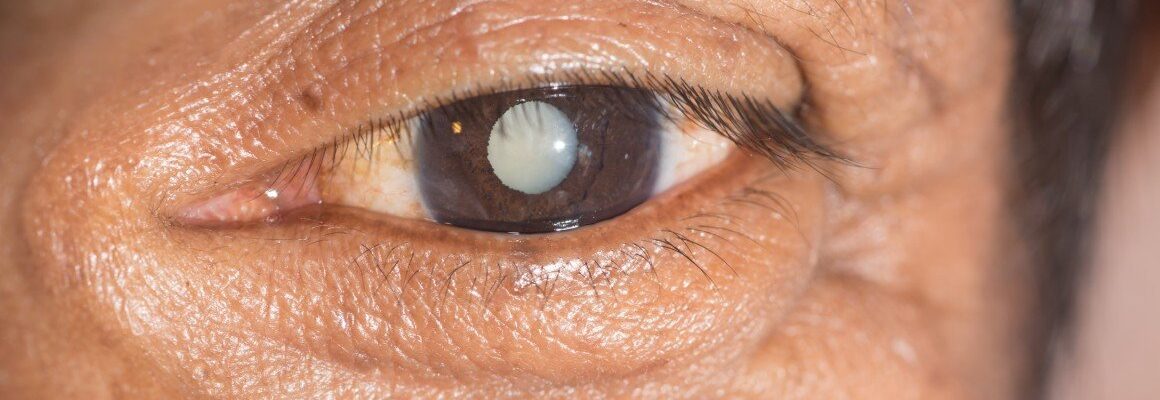Summary
Cataracts are a common eye condition, especially among older adults, characterized by cloudy patches that form on the eye’s lens, causing vision to become blurry or dull. These cloudy patches, which often appear as white spots on the eye’s lens, gradually obstruct vision and may even cause sensitivity to light.
Cataracts develop when the lens tissue in the eye changes due to aging, certain illnesses, previous eye surgeries, or other eye conditions. The most common symptoms include cloudiness on the eye’s lens, blurred vision, and increased sensitivity to light.
Currently, the most effective treatment for cataracts is surgery. During the procedure, the clouded lens is removed and replaced with an artificial one, restoring clearer vision for most patients.
Table of Contents
Symptoms of Cataracts
Cataracts develop gradually over several years and commonly affect older adults, although they can impact people at any age. Cataracts may also form in both eyes, but not always at the same rate. The symptoms often begin subtly and worsen over time, affecting daily activities.
Here are the primary symptoms associated with cataracts:
- Blurred or cloudy vision. Vision may become increasingly hazy or blurred, making it harder to see details.
- Seeing small spots or dots. Some people notice tiny, dark spots that obstruct parts of their vision, which may gradually increase in number or size.
- Cloudy patches in vision. Cloudy or opaque areas form on the lens, creating spots that obscure parts of the visual field.
- Increased blurriness in low-light settings. Vision may be especially impaired in dim light, such as in the evening, making it harder to perform tasks.
- Difficulty with bright lights or glare. Cataracts can make the eyes more sensitive to intense light or glare from sunlight, car headlights, or bright indoor lighting.
- Reduced color perception. Colors may appear faded or less vibrant, making it difficult to distinguish between certain shades.
- Difficulty reading. As cataracts progress, small text or detailed print becomes increasingly challenging to read without significant effort.
- Frequent changes in eyeglass prescription. Cataract progression may require frequent updates to glasses or contact lenses, but even with corrective lenses, vision remains compromised over time.
- Diminished effectiveness of corrective lenses. At advanced stages, glasses or contacts may no longer improve vision, as the cataracts obstruct light from reaching the retina effectively.
- Seeing halos around bright lights. Some people experience halos or rings around lights, such as car headlights, which can cause discomfort and increase difficulty with night driving.
If you notice these symptoms, regular eye exams are essential for early diagnosis and timely treatment. Cataracts worsen over time, so seeking treatment early can improve vision quality and maintain independence in daily activities.
Types of Cataracts
Cataracts are primarily age-related, but there are other types that develop due to various causes. Here are some of the main types:
- Cataracts caused by other conditions. Cataracts can develop as a complication following surgery for other eye conditions, such as glaucoma. Additionally, conditions like diabetes and long-term steroid use increase the risk of cataract formation.
- Traumatic cataracts. Cataracts may form after an eye injury, sometimes immediately or years later. The trauma disrupts the lens structure, leading to clouding over time.
- Congenital cataracts. Some babies are born with cataracts, known as congenital cataracts. These cataracts are typically small and may not affect the infant’s vision initially, though they may require monitoring or treatment if they grow.
- Radiation-induced cataracts. Prolonged exposure to radiation, such as UV rays or certain medical treatments, can also lead to cataract formation. This type of cataract often appears gradually after repeated exposure.
Understanding the type and cause of cataracts helps in determining the best course of treatment. While surgery is often effective for restoring vision, early diagnosis and management can help prevent further vision impairment.
Diagnostic Procedures for Cataracts
Diagnosing cataracts involves a series of tests performed by an eye specialist to assess vision clarity and check for clouding in the eye’s lens. Here are the primary diagnostic procedures for cataracts:
- Visual Acuity Test. This standard eye test measures how well a person can see at different distances. The patient reads letters on an eye chart to determine if vision impairment is present, which may indicate cataracts or other eye conditions.
- Slit-Lamp Examination. Using a slit lamp microscope, the eye specialist closely examines the structures of the eye, including the cornea, iris, lens, and retina. This allows for a detailed view of the lens, where any clouding or opacities caused by cataracts can be detected.
- Retinal Examination (Dilated Eye Exam). During this exam, the doctor dilates the pupil with eye drops to examine the back of the eye. Using a special lens, the doctor checks for signs of cataracts and other eye health issues, including retinal problems that can affect vision.
- Tonometry. This test measures the intraocular pressure (IOP) in the eye, which can help rule out other conditions, such as glaucoma, that can cause similar vision problems.
- Contrast Sensitivity Test. Cataracts can affect the eye’s ability to distinguish between subtle differences in shading or contrast. This test assesses contrast sensitivity to understand how the cataract may be impacting vision clarity, especially in low-light conditions.
- Glare Test. A glare test measures how the eye handles bright lights, as cataracts can cause increased sensitivity to light and glare. This test helps determine if bright conditions significantly impair vision.
These diagnostic procedures help eye specialists accurately diagnose cataracts, assess their severity, and determine the most appropriate treatment options. Regular eye exams are essential for early detection and effective management, particularly as cataracts progress slowly and may not be noticeable in their initial stages.
Complications of Untreated Cataracts
If left untreated, cataracts can lead to a range of complications that affect vision, daily activities, and overall eye health. Here are some potential complications associated with untreated cataracts:
- Progressive vision loss. Cataracts cause gradual vision deterioration, making it increasingly difficult to see clearly. This can impair the ability to perform everyday tasks such as reading, driving, and recognizing faces.
- Blindness. As cataracts worsen, they can lead to total vision loss. Untreated cataracts are a leading cause of blindness globally, particularly in older adults.
- Increased risk of falls and injuries. Poor vision due to cataracts increases the likelihood of falls and accidents, especially among older adults. This can result in fractures, head injuries, and other health complications.
- Decreased quality of life. Cataracts impact visual independence, making activities like reading, cooking, and engaging in hobbies more challenging. This can lead to frustration, loss of independence, and reduced enjoyment of daily life.
- Mental health impacts. The limitations imposed by vision loss can lead to feelings of isolation, anxiety, and depression, particularly as independence and social interactions become restricted.
- Secondary complications in the eye. Severe, untreated cataracts can sometimes lead to complications like inflammation in the eye (phacolytic glaucoma) or increased intraocular pressure (glaucoma), which can further damage vision.
Early diagnosis and treatment of cataracts can help prevent these complications. Cataract surgery is a safe, effective procedure that can restore vision and significantly improve quality of life, allowing individuals to maintain independence and reduce the risk of accidents or injury.
Causes of Cataracts
Cataracts commonly develop with age, due to changes or damage to the eye’s lens tissue. They may also be caused by genetic factors, eye injuries, surgeries, and health conditions such as diabetes. Here’s an overview of how cataracts form and additional contributing factors:
- Age-related changes. As people age, the lenses in the eyes gradually lose flexibility, thicken, and become less transparent. This aging process causes the lens tissue to break down and clump together, forming cloudy patches that obstruct vision. Over time, these cloudy areas spread, further blocking light from entering the eye and increasingly blurring vision.
- Lens structure and function. Cataracts develop on the lenses located just behind the iris (the colored part of the eye). These lenses focus incoming light to create clear images on the retina. As cataracts form, the lens’s ability to focus light diminishes, resulting in blurry vision.
- Additional contributing factors:
- Excessive exposure to ultraviolet (UV) rays. Long-term exposure to sunlight without eye protection can damage the eye’s lens, increasing the risk of cataracts.
- Chronic use of corticosteroid medications. Prolonged use of corticosteroids, often prescribed for inflammatory conditions, is associated with an elevated risk of cataracts.
- Radiation exposure. Treatments involving radiation, particularly near the upper body, can lead to cataract formation over time.
Understanding these causes can help individuals take preventive steps, such as protecting their eyes from UV rays, managing health conditions, and following safe medication practices. Regular eye exams are essential for early detection and effective management of cataracts.
Prevention of Cataracts

While there is no guaranteed way to prevent cataracts entirely or halt their progression, doctors recommend certain lifestyle habits that may help reduce the risk. These include:
- Have regular eye exams. Routine eye check-ups are essential for early detection of cataracts. An eye specialist can advise on the recommended frequency of exams based on age and risk factors.
- Quit smoking. Smoking can damage the eye’s lens, accelerating cataract formation. Seeking guidance from healthcare professionals on effective ways to quit smoking can be beneficial.
- Limit alcohol intake. Studies suggest that excessive alcohol consumption may harm the eye’s lens. Reducing alcohol intake can support overall eye health.
- Manage underlying health conditions promptly. Conditions like diabetes and glaucoma increase the risk of cataracts. Properly managing these health issues by following medical advice helps lower the likelihood of cataract development.
- Choose a nutritious diet. Fruits and vegetables rich in antioxidants, vitamins, and minerals help maintain good eye health. These nutrients can support lens health and reduce cataract risk. Those with diabetes should also limit foods high in sugar.
- Wear sunglasses. Ultraviolet (UV) rays from the sun can be damaging to the eyes. Wearing sunglasses with UV protection when outdoors helps protect the eyes from potential sun-related damage.
By following these preventive measures and maintaining a healthy lifestyle, individuals can reduce their risk of developing cataracts and preserve their vision health over time. Regular eye care and health monitoring remain key to early detection and effective management of cataracts.
Risk Factors for Cataracts

The following factors can increase the risk of developing cataracts:
- Age. Aging is the most common risk factor for cataracts, as natural changes in the eye’s lens structure make older individuals more susceptible.
- Diabetes. People with diabetes are at a higher risk for cataracts, as fluctuating blood sugar levels can affect the lens, leading to earlier or faster cataract formation.
- Excessive exposure to sunlight. Long-term exposure to ultraviolet (UV) rays from the sun without protection can increase the risk of cataracts, as UV light can damage the eye’s lens.
- Smoking. Smoking introduces harmful toxins into the body, which can contribute to oxidative stress in the eyes, accelerating cataract development.
- Obesity. Obesity is associated with an increased risk of cataracts, as it often leads to other health issues like diabetes and hypertension, which affect eye health.
- Hypertension (high blood pressure). High blood pressure can reduce blood flow to the eyes, increasing the likelihood of developing cataracts.
- Existing eye conditions or inflammation. Previous eye conditions or chronic inflammation can damage the eye’s lens, raising the risk of cataracts.
- Past eye surgery. People who have had eye surgery, especially for other conditions, may be at an increased risk for cataracts as a complication.
- Prolonged use of corticosteroid medications. Long-term corticosteroid use, often prescribed for inflammation and autoimmune conditions, is linked to a higher risk of cataract formation.
- Excessive alcohol consumption. High alcohol intake over time can lead to oxidative stress in the eyes, contributing to cataract formation.
Understanding these risk factors can help individuals take preventive steps, such as protecting eyes from UV light, managing chronic health conditions, and avoiding smoking or excessive alcohol. Early diagnosis through regular eye exams is essential for managing cataracts and preventing vision complications.
Cataract FAQs
Here are some frequently asked questions on cataracts:
- What are cataracts?
Cataracts are a common eye condition where the lens of the eye becomes cloudy, leading to blurred or impaired vision. Cataracts develop gradually, often with age, and can eventually interfere with daily activities. - What causes cataracts?
Cataracts are usually caused by age-related changes in the eye’s lens, but they can also develop due to other factors, such as diabetes, eye injuries, certain medications, and prolonged exposure to UV rays. - What are the symptoms of cataracts?
Common symptoms include blurred or cloudy vision, sensitivity to light and glare, seeing halos around lights, difficulty seeing at night, faded color perception, and frequent changes in eyeglass prescriptions. - Are cataracts only found in older adults?
While cataracts are most common in people over age 60, they can occur at any age. Some people are born with cataracts (congenital cataracts), and others may develop them due to injury, certain medications, or health conditions. - Can cataracts affect both eyes?
Yes, cataracts often develop in both eyes, though they may progress at different rates in each eye. - How are cataracts diagnosed?
An eye specialist diagnoses cataracts through a comprehensive eye exam, which may include a visual acuity test, slit-lamp examination, and dilated eye exam to check for clouding in the lens. - Can cataracts be treated without surgery?
In the early stages, stronger lighting and updated eyeglasses may help manage symptoms. However, surgery is the only effective way to fully remove cataracts once they begin significantly affecting vision. - What does cataract surgery involve?
Cataract surgery involves removing the clouded lens and replacing it with a clear artificial lens. This procedure is highly successful and typically restores clear vision for most patients. - Is cataract surgery safe?
Yes, cataract surgery is generally safe and is one of the most common surgical procedures worldwide. Most people experience improved vision and few complications. - Can cataracts come back after surgery?
Cataracts do not return after surgery; however, some patients may develop posterior capsule opacification (PCO), where the membrane holding the artificial lens becomes cloudy. This is easily treated with a quick laser procedure.
By understanding cataracts and recognizing symptoms early, individuals can seek timely medical care and maintain clearer vision. Regular eye exams are essential for monitoring eye health and addressing issues as they arise.


